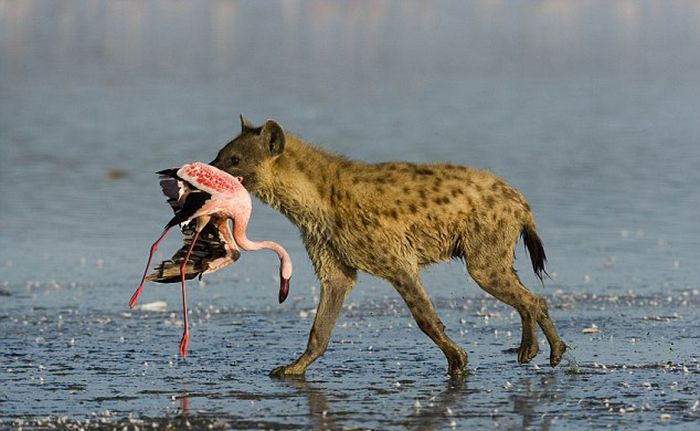|
|
Hyena Catches A Flamingo
|
• Rise of modern hyenas
The aardwolf can trace its lineage directly back to Plioviverrops 15 million years ago, and is the only survivor of the dog-like hyena lineage. Its success is partly attributed to its insectivorous diet, for which it faced no competition from canids crossing from North America. Its unrivaled ability to digest the terpene excretions from soldier termites is likely a modification of the strong digestive system its ancestors used to digest foetid carrion.
The striped hyena may have evolved from H. namaquensis of Pliocene Africa. Striped hyena fossils are common in Africa, with records going back as far as the Middle Pleistocene and even to the Villafranchian. As fossil striped hyenas are absent from the Mediterranean region, it is likely that the species is a relatively late invader to Eurasia, having likely spread outside Africa only after the extinction of spotted hyenas in Asia at the end of the Ice Age. The striped hyena occurred for some time in Europe during the Pleistocene, having been particularly widespread in France and Germany. It also occurred in Montmaurin, Hollabrunn in Austria, the Furninha Cave in Portugal and the Genista Caves in Gibraltar. The European form was similar in appearance to modern populations, but was larger, being comparable in size to the brown hyena.
The spotted hyena diverged from the striped and brown hyena 10 million years ago. Its direct ancestor was the Indian Crocuta sivalensis, which lived during the Villafranchian. Ancestral spotted hyenas probably developed social behaviours in response to increased pressure from rivals on carcasses, thus forcing them to operate in teams. Spotted hyenas evolved sharp carnassials behind their crushing premolars, therefore they did not need to wait for their prey to die, as is the case for brown and striped hyenas, and thus became pack hunters as well as scavengers. They began forming increasingly larger territories, necessitated by the fact that their prey was often migratory, and long chases in a small territory would have caused them to encroach into another clan's turf. Spotted hyenas spread from their original homeland during the Middle Pleistocene, and quickly colonised a very wide area from Europe, to southern Africa and China. With the decline of grasslands 12,500 years ago, Europe experienced a massive loss of lowland habitats favoured by spotted hyenas, and a corresponding increase in mixed woodlands. Spotted hyenas, under these circumstances, would have been outcompeted by wolves and humans, who were as much at home in forests as in open lands—and in highlands as in lowlands. Spotted hyena populations began to shrink after roughly 20,000 years ago, completely disappearing from Western Europe between 14-11,000 years ago, and earlier in some areas.
|
|









